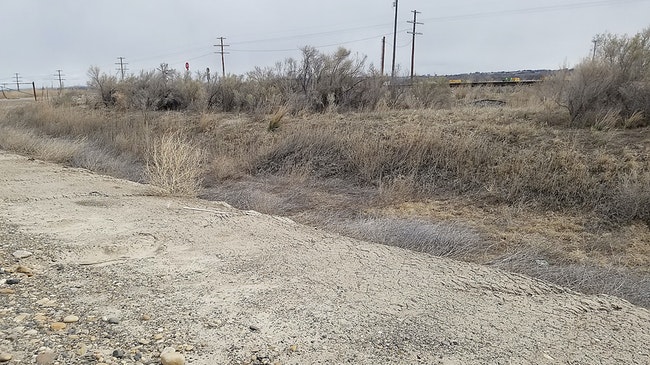
Uneven ground, wetlands and low areas will require significant amounts of fill, according to engineering estimates for the reload project. (Enterprise file photo)
NYSSA – The farmland, Malheur County officials said, was ideal as the place to plant the Treasure Valley Reload Center.
There was access to the Union Pacific Railroad line.
There was a fairly straight shot to state highways for trucking in onions.
And the 280-acre parcel north of Nyssa held the promise of future industrial jobs.
Now, county officials and their contractors are confronting one massive impediment – old irrigation canals and wetlands that lace the land.
They are as much as 6 feet lower than the existing railbed, according to engineering plans.
For Treasure Valley Reload Center to be a reality, they will have to be filled in.
New cost estimates obtained by The Enterprise show that will be an expensive undertaking – up to $6 million just to get the ground level.
That will chew through about one-fourth of the money set aside to build the rail shipping center.
And the cost could go higher.
The $6 million figure was prepared last December by the engineering firm Anderson Perry & Associates, working under contract to design the Malheur County project.
But the county has fallen behind getting the work out for bid. Meanwhile, labor shortages in the construction industry have been widely documented. Costs for materials continues to climb as the Treasure Valley moves into peak construction season.
How well Malheur County anticipated the cost of filling the lowlands isn’t clear.
Greg Smith, director of the Malheur County Economic Development Department, said in an interview in March that the cost wasn’t new, that it had been “included in the rail costs” in previous budgets.
But his own agency’s budget records indicate that isn’t accurate.
The groundwork cost of $6,151,500 was itemized for the first time in a Dec. 17, 2020, project budget done for the county’s development arm, the Malheur County Development Corp.
The budget didn’t show any corresponding drop in the price for “rail improvements.” That was reduced in December only $870,000 from the original budget – nowhere near enough cover costs for moving dirt, rock and gravel.
The engineering plans indicate the scale of that ground work.
That includes filling in 1.8 acres of wetland, requiring approximately 1,000 dump truck loads of soil.
Preparing the rest of the site to raise the reload center and lay down track will take 110,500 cubic yards of rock and another 17,400 tons of riprap. That would take roughly 10,000 dump truck loads.
A review of budgets prepared in September 2018, May 2020, December 2020 and in February show costs added and subtracted as plans were refined. In major construction projects, costs shift as unexpected issues emerge or the bill for certain elements is higher or lower than anticipated.
“It is a common finding that projects with the level of sophistication and complexity that are comparative to the Treasure Valley Reload Center develop as greater detail is obtained,” Smith said in a March email to the Enterprise.
He otherwise didn’t respond to detailed questions about major budget changes.
Neither did Brad Baird, president of Anderson Perry. His firm devises the cost estimates.
The most recent budget from Feb. 4 indicated the project costs totaled the $26 million available from the state. But the breakdown on where that money would go was $750,000 short. Smith and Baird didn’t respond to a written question about an accounting for that money.
And from the beginning, the $26 million wasn’t enough for all the work the county originally planned. Smith and his team explained to Oregon Transportation Department officials in September 2018 that they were already jettisoning some costs.
“Some desired items were excluded from the revised cost estimates to help bring the project within budget,” the county wrote.
The county dropped improvements to Oregon Highway 201 intended to provide safer truck traffic and plans for a new road to reach the rail center. It dropped one rail spur, cut the size of the shipping center building, and opted to use on-site sewer instead of tying into the Nyssa city system.
Major pieces of the budget have continued to disappear – or appear for a short time.
Through last May, for instance, the county budgeted $455,000 for “permitting/management/miscellaneous.” As of last December, that line item disappeared, and Smith and Baird didn’t answer what became of that cost.
The December budget included a new item – $425,000 for “equipment.” By February, that, too, had disappeared from the budget. Smith said Americold Logistics, which is expected to run the shipping center, would now provide that equipment.
And Smith and his team had to add on yet another unexpected cost last month, settling a dispute with a local farming operation over a rail crossing. The settlement could cost up to $400,000 – money Smith said would come from the project’s construction budget.
The centerpiece of the reload center would be the shipping building, where onions and other produce would be unloaded from trucks and shifted to rail cars.
The county originally budgeted $6.758 million for the building, reduced the price to $6 million in December but less than 60 days later amended the cost once again, this time pegging it at $6.5 million.
Even that price isn’t a certainty.
“We do not know the type of building that will be built yet,” Baird wrote in an email to the Enterprise. “We have fairly significant inflation driving up construction costs. Lumber prices have nearly tripled in the last few months.”
Because there is only $26 million to work with, Baird said that “the project is constantly undergoing modifications and revisions to keep within the available budget.”
The actual costs will come into sharper focus when contractors bid for the work, documenting what they would charge. They are not bound by budget limits in estimating the price.
Malheur County is late to the bidding party. The county had anticipated seeking bids for the groundwork in February to get construction going by mid-March.
But a key agreement the county had suggested to state officials in January was nearly in hand remains unfinished. Onion shippers and Americold still haven’t come to terms on the price for using the rail center. That’s holding up the county’s own deal with Americold to operate the Nyssa center.
Smith wouldn’t provide a schedule for construction to start.
“Bids will be released when agreements are signed,” Smith said via email. “Construction will follow.”
Reporter Pat Caldwell contributed to this report.
Contact Editor Les Zaitz by email: [email protected].
SAFEGUARD YOUR LOCAL NEWS
Take one action today to help the Enterprise grow and do more for the community through accurate, fair reporting.
SUBSCRIBE: A monthly digital subscription is $5 a month.
GIFT: Give someone you know a subscription.
ONE-TIME PAYMENT: Contribute, knowing your support goes towards more local journalism you can trust.




